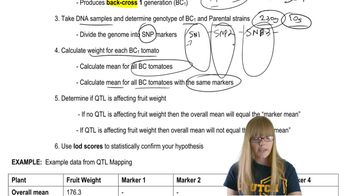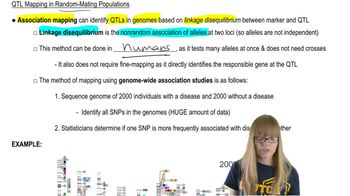Table of contents
- 1. Introduction to Genetics51m
- 2. Mendel's Laws of Inheritance3h 37m
- 3. Extensions to Mendelian Inheritance2h 41m
- 4. Genetic Mapping and Linkage2h 28m
- 5. Genetics of Bacteria and Viruses1h 21m
- 6. Chromosomal Variation1h 48m
- 7. DNA and Chromosome Structure56m
- 8. DNA Replication1h 10m
- 9. Mitosis and Meiosis1h 34m
- 10. Transcription1h 0m
- 11. Translation58m
- 12. Gene Regulation in Prokaryotes1h 19m
- 13. Gene Regulation in Eukaryotes44m
- 14. Genetic Control of Development44m
- 15. Genomes and Genomics1h 50m
- 16. Transposable Elements47m
- 17. Mutation, Repair, and Recombination1h 6m
- 18. Molecular Genetic Tools19m
- 19. Cancer Genetics29m
- 20. Quantitative Genetics1h 26m
- 21. Population Genetics50m
- 22. Evolutionary Genetics29m
20. Quantitative Genetics
QTL Mapping
Problem 29d
Textbook Question
Textbook QuestionIn 1988, Horst Wilkens investigated blind cavefish, comparing them with members of a sibling species with normal vision that are found in a lake [Wilkens, H. (1988). Evol. Biol. 25:271–367]. We will call them cavefish and lakefish. Wilkens found that cavefish eyes are about seven times smaller than lakefish eyes. F₁ hybrids have eyes of intermediate size. These data, as well as the F₁×F₁ cross and those from backcrosses (F₁×cavefish and F₁×lakefish), are depicted below. Examine Wilkens's results and respond to the following questions:
Based on the results of the F₁ backcross with lakefish, is your explanation supported? Explain.
 Verified Solution
Verified SolutionThis video solution was recommended by our tutors as helpful for the problem above
Video duration:
1mPlay a video:
Was this helpful?
Key Concepts
Here are the essential concepts you must grasp in order to answer the question correctly.
Hybrid Vigor and Intermediate Traits
Hybrid vigor, or heterosis, refers to the phenomenon where hybrid offspring exhibit traits that are intermediate between their parent species. In the case of the cavefish and lakefish, the F₁ hybrids have eyes that are smaller than lakefish but larger than cavefish, indicating that the trait for eye size is influenced by both parental genotypes. Understanding this concept is crucial for analyzing the inheritance patterns observed in the hybrids.
Recommended video:
Guided course

Traits and Variance
Backcrossing
Backcrossing is a breeding method where hybrid offspring are crossed with one of their parent species to analyze the inheritance of specific traits. In this scenario, the F₁ backcross with lakefish allows researchers to determine how the eye size trait is inherited and whether the traits from the lakefish parent dominate. This method is essential for understanding the genetic contributions of each parent to the offspring's phenotype.
Recommended video:
Guided course

QTL Mapping
Quantitative Trait Loci (QTL)
Quantitative Trait Loci (QTL) are regions of the genome that are associated with the variation in a quantitative trait, such as eye size. The study of QTL helps in identifying the genetic basis of traits that show continuous variation, like the eye size in cavefish and lakefish. Recognizing the role of QTL is important for interpreting the results of the backcross and understanding the genetic architecture underlying the observed phenotypic differences.
Recommended video:
Guided course

QTL Mapping
Related Videos
Related Practice




